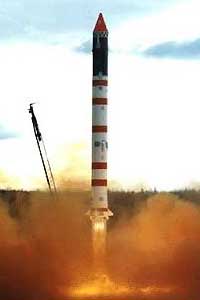Kosmos L V
Kosmos Launch Vehicle
The SL-7 Kosmos (Type B-1) booster was designed by M K Yangel Design Buearu. It was used for the first Kosmos launch on March 16, 1962. It consisted of a modified SS-4 first stage and an added second stage. The SS-4 was in fact a stretched version of the SS-3 missile. The first stage was 19.7 meters long and 1.65 meters wide. The first stage used the RD-214 variable thrust engine with a thrust of 74,000 kg. using Kerosene and Nitric Acid as propellants. On top of the first stage is a truss structure that supports the second stage. The second stage was 6.7 meters long and 1.65 meters wide. The second stage thrust was 11,000 kg. using the RD-119 variable thrust engine using UDMH/LOX propellants. This system was used mainly for launching satellites weighing from 130 to 450 kg. After 1974, all B-1 launches were made from Plesetsk. The B-1 was phased out by the C-1 booster in 1977 after 15 years of service. India's first satellite Aryabatta and the consequent Bhaskara series were launched by Kosmos vehicles.
Kosmos 3M
The SL-8 Kosmos 3M (Type-C) booster consisted of an SS-5 first stage and a restartable second stage. It was also called the Vertical booster. It was first used to launch Kosmos 38-40 and it replaced the B-1 by 1977. The first stage had two RD-216 engines, each with two combustion chambers, that burned UDMH/IRNFA producing 176,000 kg. thrust. The first stage was 21.5 meters long, and the second stage was 6.5 meters long. The standard launch shroud brought total length to 31 meters, and diameter was 2.5 meters. The C-1 was used to launch the Soviet anti-satellite (ASAT) weapon test flights in the 1970s. The C type also launched the BOR space plane tests of the 1980s which was related to the development of the Soviet space shuttle.(Russian Aerospace Guide)




